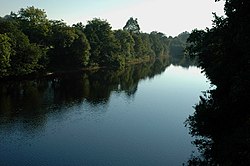Dunglass Island
| Dunglass Island Gaelic: Innis Dhùn Ghlais | |

| |
|---|---|
| Location | |
| Location: | 57°33’26"N, 4°26’57"W |
| Area: | 100 acres |
| Highest point: | 26 ft[1] |
| Data | |
Dunglass Island is an uninhabited island in the River Conon south-west of the village of Conon Bridge in Ross-shire. At approximately 100 acres in extent, it is one of Scotland's largest freshwater islands.
The island, which contains the site of an Iron Age fort, can be reached by a wooden road bridge accessed by a track leading from the farm of Dunglass on the west side of the river or across a footbridge that spans a weir at the south-west extremity of the island.[1][2]
Following a substantial flood in 1892, Nairne described the island as follows:[3]
Port of Dunglass farm, about 100 acres, consists of Dunglass Island in the river and the embankment here broke, with the result that over twenty acres was covered with a thick layer of gravel that renders it unfit for further tillage. The Conon channel used to be the larger of the two but a gravel bank was thrown across above the Islands, and the greatest part of the river, for a time flowed through the Dunglass channel. The diversion of the river caused enormous damage to salmon ova, as the breeding banks were left dry, and something like a million ova practically became useless.
In 2004, a £38,000 biodiversity project involving Scottish Natural Heritage, Conon District Salmon Fishery Board, Brahan Estates, the Highland Council and Ross and Cromarty Enterprise was undertaken. Dense plantation woodland was removed and 400 tons of cobblestones repositioned to aid salmon spawning, which also benefited other river species such as lampreys.[4] This work restored an alder-lined channel through the island, which had become "defunct".[5][6]
Notes
- ↑ 1.0 1.1 Ordnance Survey
- ↑ "Dunglass Island and the Conon, Maryburgh" walkhighlands.co.uk. Retrieved 24 January 2010.
- ↑ Nairne , D. (1895) Memorable Floods in the Highlands during the Nineteenth Century: Part Fifth. quoted in Historical Survey of the River Conon. (2000) (pdf) Scottish Natural Heritage Commissioned Report F00PA40 p. 23.
- ↑ "Conon project attracts more salmon" (7 September 2004). SNH. Retrieved 24 January 2010.
- ↑ "River Restoration News" (pdf) (March 2005) Issue 20. River Restoration Centre. Retrieved 24 January 2010.
- ↑ "River Restoration News" (pdf) (July 2005) Issue 21.